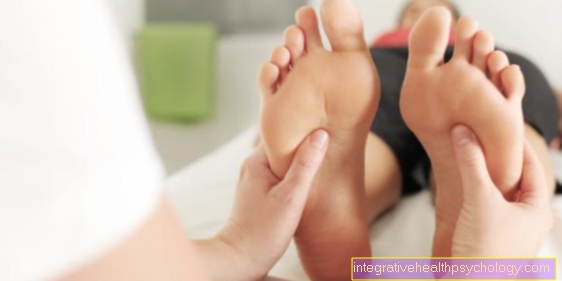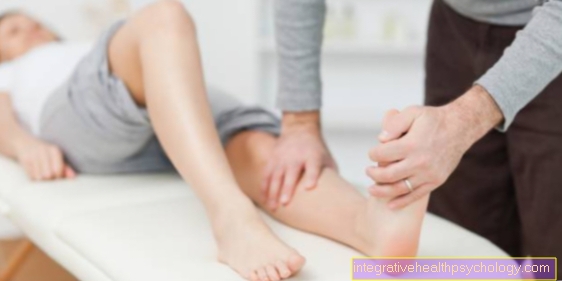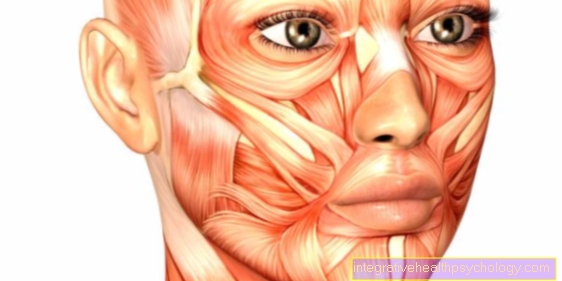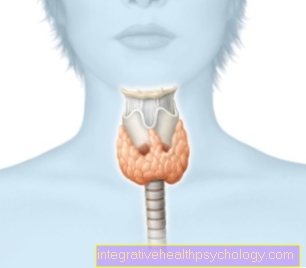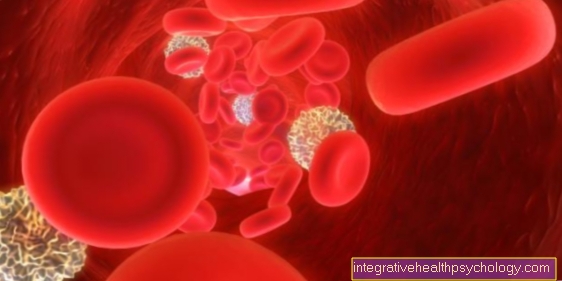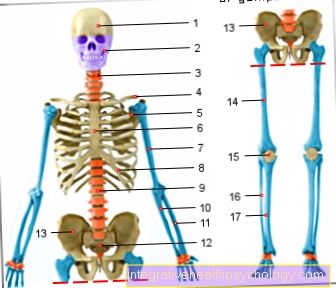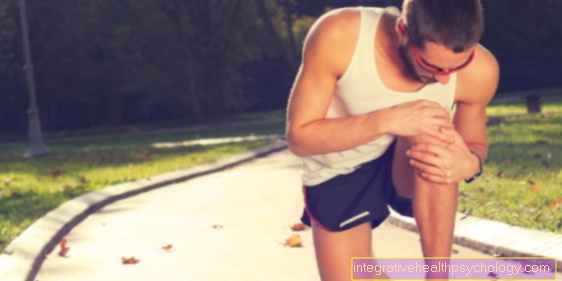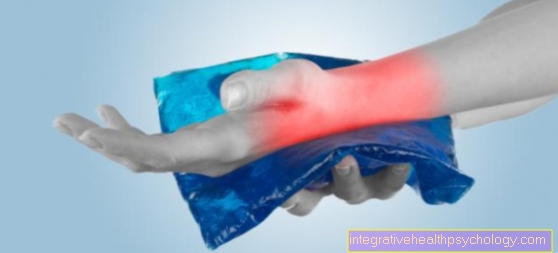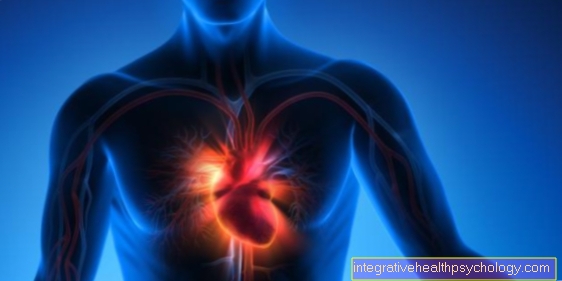Pain in the buttocks / buttocks
introduction
In medicine, the buttock describes the gluteal muscles and the subcutaneous fat layer, which on the one hand cushions the weight of the body while sitting, but on the other also performs powerful muscle movements. A pain in the buttock can have many causes.
Overloading can lead to muscle strains or muscle fiber tears. Back pain is also a common problem, as it can radiate into the buttocks and down to the foot. Irritation of the nerves, especially the sciatic nerve, can also cause burning pain.

Causes of pain in the buttock
Pain in the buttocks can only arise in one place or radiate into the legs or back. In many cases, this pain in the buttocks is due to muscular causes. Depending on the location of the complaints, however, nervous irregularities and / or problems at the level of the bony structures can also be the cause. In addition, diseases of the spine can cause pain in the buttocks area for many patients.
- Unilateral pain in the buttocks
Buttocks pain that is strictly limited to one side is in most cases caused by incorrect posture. With prolonged overloading and excessive lateral displacement of the upper body, the pain symptoms usually develop in the area of the stressed leg. Basically, unilateral pain in the buttocks is less due to a disease of the buttocks. Rather, most patients who suffer from unilateral pain in the buttocks are problems of the spine that radiate into the buttocks.
Find out more here: Pain in the right buttock or pain in the left buttock.
- Pain on both sides of the bottom
Patients who feel pain on both sides of the buttocks, which also affect the entire area of the gluteal muscles, are often based on stress on the muscular structures. Many of the affected patients tend to keep the gluteal muscles tense all the time. This type of buttock pain usually affects athletes and women. - Pain in the buttocks above
Pain in the buttocks that radiate into the lumbar spine is particularly common. In most cases, these symptoms are described by the affected patients as back pain or lower back pain. A herniated disc can also lead to such pain. However, since the gluteal muscle begins at the upper edge of the pelvis, muscular problems of the buttocks can also lead to such pain symptoms. - Pain in the ischium
Patients with pain in the ischial area can usually hardly put any weight on their buttocks. Those affected can find even short periods of sitting very distressing. This phenomenon is based on the fact that the ischia are the lowest points of the bony pelvis. In a sitting position, the entire body weight acts on these two small points and increases the pain symptoms enormously. As a rule, the pain in the buttocks felt by the patient is less likely to be projected onto the gluteal region when the ischial bone is present. In general, the symptoms are rather described on the lower parts of the buttocks and the back of the thighs. This type of pain in the buttocks is often due to a misalignment of the legs (for example, a leg length difference) or the bony pelvis (pelvic obliquity). - A sudden sharp pain and swelling or bruise in the affected area can indicate a torn muscle fiber. This often occurs when the muscles are not properly warmed up. You should cool and protect the affected area and refrain from exercising until it has healed completely after about 6 weeks.
Sciatic pain as the cause
The sciatic nerve is the longest nerve in the human body. It extends from the spine to the foot and can be damaged in its course. The nerve is responsible for the sensation in the buttock and can cause pain if irritated.
Due to the anatomical proximity, the sciatica is often crushed by a tense hip muscle (M.piriformis), also called piriformis syndrome, or inflammation of the nerves. In addition to pain in the buttock, pulling down into the leg is often described. This can be caused by prolonged sitting, incorrect or jerky movement, or permanent misalignment when standing and walking.
Physiotherapy, walking training and massages are suitable for therapy. Anti-inflammatory pain relievers such as diclofenac help relieve pain, especially if the sciatica is inflamed. Surgery is rarely indicated.
For more information read on: pinched sciatic nerve.
The piriformis syndrome as the cause
The piriformis muscle is a small pear-shaped muscle that is located in the pelvis at the transition to the back of the thigh. This muscle can be irritated by overstressing in particular; hardening of the piriformis then leads to pain in the buttock and the back of the thigh.
The piriformis muscle can also irritate the sciatic nerve, which can cause shooting pain in the entire leg and the affected buttocks. In addition, abnormal sensations and a feeling of numbness can occur.
Find out more about the topic here: Piriformis Syndrome.
The ISG blockade as the cause
The sacroiliac joint connects the sacrum on both sides with the iliac bones. It is part of the pelvic ring. The SI joint is a so-called amphiarthrosis, that is, it is a joint with a very small range of motion. It is stabilized by muscles and ligaments.
A blockage of the sacroiliac joint can be triggered by a variety of causes. A muscular imbalance of the back and abdominal muscles is often the reason for the complaints. This can be triggered by non-physiological movements, heavy physical work, especially lifting, or by an inclined pelvis. Falls or other trauma can also cause an ISG blockade. This usually manifests itself with unspecific low back pain, which often radiates to the bottom and thigh.
Lying on your back with your legs straight is not possible with an ISG block. ISG blockage is particularly common during pregnancy. Here, the joint is heavily stressed due to the growing baby, in addition, the ligaments are loosened by hormone release from the expectant mother. The symptoms of an SI joint blockage are often similar to those of a herniated disc. A thorough investigation is important here, as the blockage can be treated well with chiropractic and physiotherapy.
Read more about the topic here: ISG blockage.
The hip as the cause
Pain in the buttock area can have various causes. In many cases, diseases of the hip can be detected. Mostly it is pain that radiates from the hip.
One of the main causes of such complaints is what is known as hip arthrosis. Arthrosis is a disease that is characterized by extensive cartilage damage. In many of the affected patients, the real reason for the occurrence of this cartilage damage cannot be determined even after extensive diagnostics. In other cases, however, incorrect posture and / or improper stress can be identified as the cause.
Another cause of pain in the buttock is what is known as "trochanteric bursitis". In this clinical picture, pronounced inflammatory processes can be detected in the area of the bursa of the upper thigh. The direct cause of the occurrence of this disease is the friction of the tendon plate of the outer thigh (Fascia lata) on the bony greater trochanter. Trochanteric bursitis can basically occur in all age groups. Particularly at risk are people who are often involved in sports and in this way put a lot of strain on the thigh muscles.
Furthermore, a bottleneck syndrome of the hip joint (impingement of the hip joint) can lead to groin pain in the affected patients, which radiates into the buttock. The reason for the occurrence of this bottleneck syndrome is an unfavorable anatomical shape of the femoral head and / or the acetabular roof.
The sore muscles as the cause
Sore muscles in the glutes are a very common cause of pain in the buttock. This comes about through unusual stress or an extreme increase in stress. Often it is hikes over mountains or long squats that lead to it. It is the so-called gluteal muscles that are responsible for the sore muscles. There are three pieces: a large, medium and small (gluteus maximus / medius / minimus muscle). The sore muscles typically reach their maximum on the second day after exercise and then go away on their own.
For more information, read on: Aching.
The hemorrhoids as the cause
Hemorrhoids can also lead to painful complaints in the buttocks area. Hemorrhoids are plexuses of blood vessels in the area of the anus. These occur in everyone and usually do not cause any symptoms. On the contrary, they are even very important for stool continence because they seal off the rectum from air and liquid stool. However, disease value has an expansion of this network beyond the normal extent. Parts of this braid can then fall down from the anal canal and become externally visible.
The first signs of hemorrhoids are usually bright red deposits of blood on the stool. In the course of the disease, however, the function of the vascular network can be so impaired that small amounts of mucus or stool leak between the stool and irritate the anus. This then leads to itching, oozing, burning but also pain in the area of the anus.
It is important to know that hemorrhoids are usually treatable and can be cured. The earlier the hemorrhoids are treated, the better the healing success. However, since many people are reluctant to address these complaints out of shame, most patients endure the complaints much longer than they should.
You can find more information on this topic here: Hemorrhoids.
The accompanying symptoms
Leg pain as a symptom
Buttock pain does not occur alone in many cases. Often when walking or at rest, pain shoots from the buttock into the leg to the foot. This typical constellation is found when nerves that arise from the lower spinal cord are irritated in any way. One possible cause that is assumed for pain from the buttock to the leg is a herniated disc in the lumbar spine. The intervertebral disc presses on the nerves, which are then excessively irritated and cause pain.
However, in many cases another cause is the cause of the suffering: this includes sciatica, an irritation of the sciatic nerves. There is no intervertebral disc but a tense muscle at hip level, the piriformism muscle, which is responsible for the pain up to the leg. The symptoms are often wrong movements and excessive strain.
A doctor can use various maneuvers in the leg and hip joint to find out or at least narrow down the causes. The treatment of pain from the buttock to the leg is in most cases characterized by gymnastics and relaxing exercises. Known painkillers can be used against acute pain.
Pain in the foot as a symptom
If the pain extends from the buttock to the foot, it is often what is known as sciatica. This is usually noticeable as a stabbing pain that runs from the hips over the buttocks to the leg and foot. Often times, the pain is accompanied by a feeling of numbness or tingling in the area.
It is caused by compression of the sciatic nerve. This can be caused by sliding vertebrae, protruding intervertebral discs, a herniated disc, narrowing of the vertebral canal or by bleeding or tumors.
Find out more about: Lumboischialgia.
Thigh pain as a symptom
In addition to the pain in a buttock, a pain pulling into the thigh is often described. This can be an indication of various problems.
On the one hand, pain occurs from the buttock to the thigh when the sciatic nerve is irritated, and sometimes the pain goes even further. Another cause is tension in the gluteal muscles. If there is excessive or incorrect loading and thus tension, pain occurs primarily on the back of the thigh. This can appear after long car journeys and other sedentary activities without much variety. Irritation of the sciatica produces similar symptoms.
Another cause of pain that starts in the buttock and spreads to the thigh is wear and tear on the hip (Coxarthrosis) with the following deformities. Because of this misalignment, the muscles have to work more under unusual stress and can cramp. This problem is most common in older people over 50 years of age. Here the pain is particularly emphasized on the side. The tension can be treated well with massages, heat treatment and gymnastic exercises to relax the muscles.
Read more on the topic: Thigh pain.
Back pain as a symptom
Pain in the buttock is often caused by diseases of the spine. In addition, pain that occurs directly in the area of the buttock is mistakenly perceived by many of the affected patients as back complaints.
Excessive strain on the gluteal muscles is the main cause of pain in the buttock, which can radiate into the back. Muscle strains and bruises are particularly common in the buttock area. In addition, simple sore muscles can cause pain in the buttock and lower back in many patients.
Functional disorders of the holding organs are also among the most frequent reasons for the development of such symptoms. In this context, different forms of functional disorders must be distinguished. For example, tense muscles or tendons can turn into so-called "myofascial pain" to lead. Above all, people who have pronounced posture errors or who repeatedly perform monotonous movements often suffer from myofascial pain in the buttock and lower back.
When does the pain occur?
After a fall
Buttock pain after a fall can have various causes. On the one hand, a bruise (hematoma) can form as the force has injured small vessels and bleeding into it. This is usually harmless. Depending on how severe the force was, it can also lead to a sacroiliac joint blockage or sciatica. This manifests itself in pain in the area of the hips and buttocks, which often radiate into the leg and foot.
If there is bony involvement, a chiropractor should be called in to loosen the blockage again and avoid permanent misalignment and incorrect loading.
While jogging
Pain in the buttock when jogging is often caused by sore muscles after overuse of the gluteal muscles. This is harmless and will go away by itself after a few days with moderate exercise. If this is not the case, there could be a torn muscle fiber that requires some time off from training.
Another cause of postural pain in runners is what is known as piriformis syndrome. The piriformis muscle is a small muscle of the hip that is responsible for stretching, rotating outward, and splaying the hip. This muscle can be irritated or it can be unnaturally thickened due to improper use. There is pain, especially when exercising, such as running, which often radiates to the leg.
But sciatica can also occur due to improper stress while jogging. Common causes for this are misalignments in the pelvis, which are associated with a leg length difference.
While running
The gluteal muscles and nerves play an important role in walking and running. As a result, it is not uncommon for buttock pain to often appear or worsen while walking. Many reasons for pain in the buttock are harmless in nature. Often, pain in the buttock occurs when running due to excessive strain or improper strain on muscles, tendons and connective tissue. It leads to hardening and tension. New and unfamiliar strains are often the trigger for pain in the buttock. This can be remedied by strengthening exercises and relaxing measures such as massages and heat treatment.
In some cases piriformis syndrome is responsible for the pain while running. This is a small, tense muscle in the hip that is in close proximity to a large nerve called sciatica. This is squeezed in and causes pain in the buttock. It hurts especially when running, because this is where the muscle is used. If the symptoms do not subside after a few days without exercise despite relaxation exercises, further clarification is necessary.
When sitting
Pain in the buttock when sitting can have various causes. Since the entire weight of the torso acts on the ischial tuberosities (these are the bony structures of the pelvis) when sitting, they are often exposed to extremely high loads for many hours a day. In people with a congenital or acquired malalignment of the pelvis or a leg length difference, the body weight often has an unfavorable effect on the pelvis. In the long run, this can lead to unilateral or bilateral pain in the buttocks when sitting.
Sciatica or piriformis syndrome should also be considered. Also relatively harmless causes, such as a bruise or sore muscles, can cause pain when sitting.
Laying
Most people notice pain in the buttock especially when they are exerted, i.e. when sitting for long periods of time or when walking or running. But even when lying down, the pain in one buttock can occur and require treatment. There are several possible reasons for this:
In the first place there is a general overload of the corresponding muscles in the buttocks and hip area. The irritated ligaments involved can also cause pain in the buttock when lying down. A simple sore muscles after hard training should not be forgotten.
If the pain remains constant over a long period of time, a problem with the sciatic nerve must be considered. This large nerve can be directly inflamed, which causes severe pain even when lying down. In piriformis syndrome, tension in a small hip muscle results in compression of the sciatica, which causes similar symptoms.
Misalignments and incorrect loads should then be corrected by an orthopedic surgeon. Even if the pain in the buttock occurs at rest and when lying down, the suffering can usually be improved significantly with simple physiotherapeutic and relaxing means.
Where does the pain occur?
Pain in the buttock - outside
Pain in the outer buttock is often a result of sore muscles caused by frequent lateral spreading of the leg. However, there may also be an inflammation of the bursa on the side of the thigh. This is what is known as trochanteric bursitis. It is caused by overload and requires that the affected leg be protected. Exercise, such as jogging, should be avoided for some time, after which the pain usually subsides on its own.
diagnosis
Since the causes of pain in the buttocks can be many and varied, a doctor should be consulted urgently if the problem persists and the reason for the complaints clarified. The first and most important step in the diagnosis of pain in the buttocks is a detailed doctor-patient consultation (anamnese). During this conversation, the patient concerned should describe as precisely as possible where the pain in the buttocks occurs and when it was first noticed. The quality of the pain (stabbing, dull, burning) can also provide an initial indication of the underlying disease.
This doctor-patient discussion is followed by a physical examination. The attending physician will first examine the buttock region and the spine. Afterwards, various tests are carried out that make possible movement restrictions understandable and / or that can provoke the pain. In addition, the pelvis and knee joints are inspected and examined for irregularities.The relationship between the two legs should also be compared during the physical examination, so that a leg length difference should be excluded. In this way, the possible causes of the buttocks pain can be further limited.
If the findings are unclear, i.e. in cases in which no clear diagnosis can be made even after the physical examination, further steps may be useful. In some cases, imaging, such as an X-ray or CT scan, is requested.
also read: Pain over the bottom
therapy
In the case of acute pain in the buttocks, pain medication can be taken first. Above all, painkillers that contain the active ingredients paracetamol or ibuprofen can initially provide relief to the affected patient in the event of acute symptoms.
If the pain in the buttocks is due to an inflammatory cause, then taking ibuprofen is the better choice. This fact is due to the fact that, unlike paracetamol, ibuprofen also has anti-inflammatory properties. In addition, applying cold by placing a cooling pad or applying an ointment can provide pain relief. However, it must be ensured that the cooling should not take place directly on the defenseless skin. However, strains of the gluteal muscles can be treated by using warming ointments and plasters.
In addition, a patient with acute pain in the buttocks should initially refrain from physical stress and take it easy.
Proper treatment for buttock pain is highly dependent on the underlying condition. Physiotherapeutic treatment is initiated for many of the causes responsible for pain in the buttocks. In this way, a compensatory muscle build-up and relief of the painful region of the body can be achieved. Tension can be relieved with medical massages.
In the event of a leg or pelvic misalignment, the leg length should be compensated for by making special shoe insoles.
If there is a deep herniated disc in the lumbar spine at the level of the lumbar spine, orthopedic treatment is usually initiated. If the pain in the buttocks and the back is the only symptom, purely conservative therapy is usually used. The affected patients are primarily encouraged to take physical rest and to take medication for pain.
If, in the course of conservative treatment, there is no improvement in the symptoms and / or further symptoms such as muscle weakness, paralysis or sensory disturbances occur, surgical therapy should be considered.
Find out all about the topic here: Treatment of a herniated disc.
prevention
Because pain in the buttocks for many of those affected Posture damage and incorrectly executed movements In most cases, simple measures can already help prevent such pain symptoms.
In order to avoid pain in the buttocks in the first place, you should Precautions taken during everyday movements become. In many patients, the pain in the buttocks can be due to the Lifting heavy objects, frequent stooping and sports can be returned without prior warming up. In addition, those patients who often sit in front of the computer for hours often suffer from pain in their buttocks. For this reason, such pain symptoms can already be avoided by a Change of lifestyle effectively prevent. For example, when lifting heavy objects, care should be taken not to lean the upper body forward. This leads to a enormous stress on the gluteal muscles. Heavy objects should therefore always be lifted from the knees with an upright, straight back. People who work in the office and often sit at the computer should now and then take short breaks to relax the muscles. In addition, simple gymnastics exercises can be used to prevent pain in the buttocks caused by incorrect loading.
Pain in the buttock during pregnancy
Pain in the buttock area is not uncommon during pregnancy. In most cases, these symptoms are caused by irritation of the sciatic nerve during pregnancy. Sciatica complaints can be very uncomfortable for the affected patient and lead to pain that radiates from the lower back to the buttock.
Read more on the topic: Lumboischialgia in pregnancy
Often women even feel discomfort during pregnancy that begins in the lower back and continues into the thighs. The cause of these pain symptoms lies in the gluteal muscles themselves. Due to the increasing weight of the abdomen, the muscles of the buttocks are exposed to enormous stress. Because of this, the glutes often gain mass. As a result, during pregnancy it can happen that strong forces act on the sciatic nerve and push it off. Affected women can remedy the situation with the local application of warmth (for example with warming patches). In addition, targeted stretching exercises and light massages can help alleviate the pain in the back and buttock.
Another cause of sciatic symptoms during pregnancy is the unborn child itself. Especially in advanced pregnancy, the weight of the child can press on the sciatic nerve and lead to pain in the lower back and buttock.
Ailments caused by compression of the sciatic nerve should also be treated during pregnancy. Otherwise there is a risk that the acute symptoms will develop into chronic pain. For this reason, women who experience very severe pain in the lower back and buttock during pregnancy should see a doctor. He or she may prescribe anti-inflammatory medication. However, complete freedom from pain cannot be guaranteed despite taking these medicines during pregnancy.
In the women affected, the symptoms usually go away completely immediately after giving birth. Permanent damage from compression of the sciatic nerve is extremely rare.
Read more about this under: Pain in the buttock during pregnancy
With children
Since it is often difficult for children to state what exactly is hurting them, there can be many causes for pain in the buttock. On the one hand, the pain can be caused by trauma, for example after falling on the buttocks and a resulting bruise. This does not necessarily have to be visible. A so-called hip runny nose can also cause pain in the child's buttock, which can become so severe that walking is no longer possible.
But also causes that are not related to the buttocks, but rather to the anus, should be considered. These include, for example, long-lasting diarrhea, which irritates the skin, or worms colonize the intestines. In this case, the buttocks tend to be itchy, which is difficult to distinguish from pain, especially in children.


